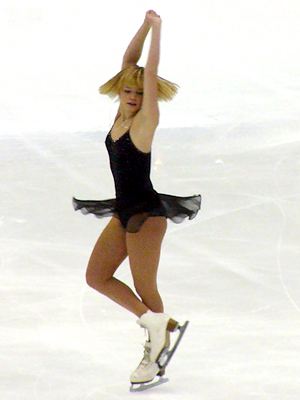Rotation Speed
Why do some spins start slowly before speeding up?
When a skater starts a spin, he would typically want it to be a bit slower compared to their top speed to that he can find his balance and center the spin. This helps the skater avoid propagating any errors from the entry into later stages of the spin, where they could cause a fall. The physics of the speed-up itself comes from the concept of moment of inertia:
Applying Rotational Motion To Rotating Skaters
Let us assume that a spinning skater is rotating about a single point on the ice (as described in the spin page, they don't, but we can ignore that here). In this case, we can describe his motion using the equation

Since skaters cannot push off the ice to get additional energy after entering the spin, kinetic energy is conserved. If we use basic algebra, we will see that decreasing the moment of inertia will increase omega, the skater's angular velocity. Also note that there is indeed a force of friction at play causing the spin to slow. Otherwise spins would last indefinitely
Great! So How Do We Reduce I?
It's a little more complicated than a one word answer, but let's assume the skater is a cylinder:

According to this equation, one option is to tell the skater to lose some weight. However, many skaters are very self-conscious about their figure, so this could give them some sort of complex. A better option would be to reduce the radius of the cylinder, which skaters can do by pulling in their arms and free leg. In fact, a scratch spin, which is generally the fastest spin in skating, has skaters wrap their free leg around their body to get the tightest radius possible:

Elena Sokolova Preforming A Scratch Spin, 2004
Didn't you say that I was more complicated than that?
It is, in fact. Figure skating judges are fickle people, and they are rarely satisfied with just an upright spin, even if it is blisteringly fast. Two common variations of spins include the sit spin (in which the skater does a one foot squat while spinning) and the camel spin:
Michael Weiss Preforming A Camel Spin, 1998 Olympics
It is very clear that the camel spin is physically different than the upright spin. In this case, the skater's spinning radius is fixed at his height, and the moment of inertia is more appropriately calculated as a rod rotating about its center rather than a cylinder. All of this means that a camel spin is generally much slower than other types of spins.
Combination Spins
Taking the above information into account, it makes sense that skaters are able to do such dizzying combinations as going from a camel spin to a sit spin to an upright spin while maintaining a constant speed: by continuously decreasing their moment of inertia, they can maintain a constant spin velocity over a long period of time rather than "cashing out" for speed all at once.
